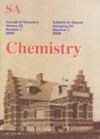用纸基共沉淀法分析水样中痕量镍
IF 1
4区 化学
Q4 CHEMISTRY, MULTIDISCIPLINARY
South African Journal of Chemistry-Suid-Afrikaanse Tydskrif Vir Chemie
Pub Date : 2023-01-01
DOI:10.17159/0379-4350/2023/v77a01
引用次数: 0
摘要
开发了一种简单、快速、低成本、灵敏的微流控纸基分析装置(u-PADs),该装置集成了共沉淀富集程序,用于分析自来水和矿泉水样品中的Ni(II)。对pH、4000rpm离心5min、试剂用量等影响因素进行了优化。检测限为0.009 mg L-1,线性范围为0.03 ~ 2.00 mg L-1,日内、日间精密度分别为4.7和5.6%。对自来水和矿泉水样品进行了回收试验,并对共沉淀富集后的u-PADs进行了分析。采用电感耦合等离子体发射光谱法(ICP-OES)对所得结果进行了验证。本方法加样回收率为92.4 ~ 106.8%,ICP-OES加样回收率为92.9 ~ 97.2%。两组(u-PADs和ICP-OES)结果一致,配对t检验显示无显著差异。所提出的方法可用于分析发展中国家水样中痕量Ni(II)水平,在这些国家,传统分析仪器的可用性是一个重大问题。本文章由计算机程序翻译,如有差异,请以英文原文为准。
Trace nickel analysis in water samples via paper-based devices coupled with co-precipitation
A simple, fast, low-cost and sensitive microfluidic paper-based analytical device (u-PADs) integrated with the co-precipitation enrichment procedure was developed to analyse Ni(II) in tap and mineral water samples. The impacting factors, including pH, centrifugation (5 min at 4000 rpm), and amounts of reagents were optimized. The limit of detection of 0.009 mg L-1 and linear range of 0.03-2.00 mg L-1 were achieved with good intra- and inter-day precision (4.7 and 5.6% RSD, respectively). The recovery tests were conducted by spiking tap and mineral water samples and analyzed using the u-PADs after co-precipitation enrichment. The results obtained by the proposed method were validated by inductively coupled plasma-optical emission spectrometry (ICP-OES). The recoveries of the present method and ICP-OES were ranged from 92.4-106.8% and 92.9-97.2%, respectively. The two sets of (u-PADs and ICP-OES) results were in good agreement, as a paired t-test indicated no significant differences. The proposed method could be utilized for analyzing trace levels of Ni(II) in water samples in developing countries where the availability of conventional analytical instruments are significant problems.
求助全文
通过发布文献求助,成功后即可免费获取论文全文。
去求助
来源期刊
CiteScore
3.10
自引率
0.00%
发文量
6
审稿时长
>12 weeks
期刊介绍:
Original work in all branches of chemistry is published in the South African Journal of Chemistry. Contributions in English may take the form of papers, short communications, or critical reviews.

 求助内容:
求助内容: 应助结果提醒方式:
应助结果提醒方式:


